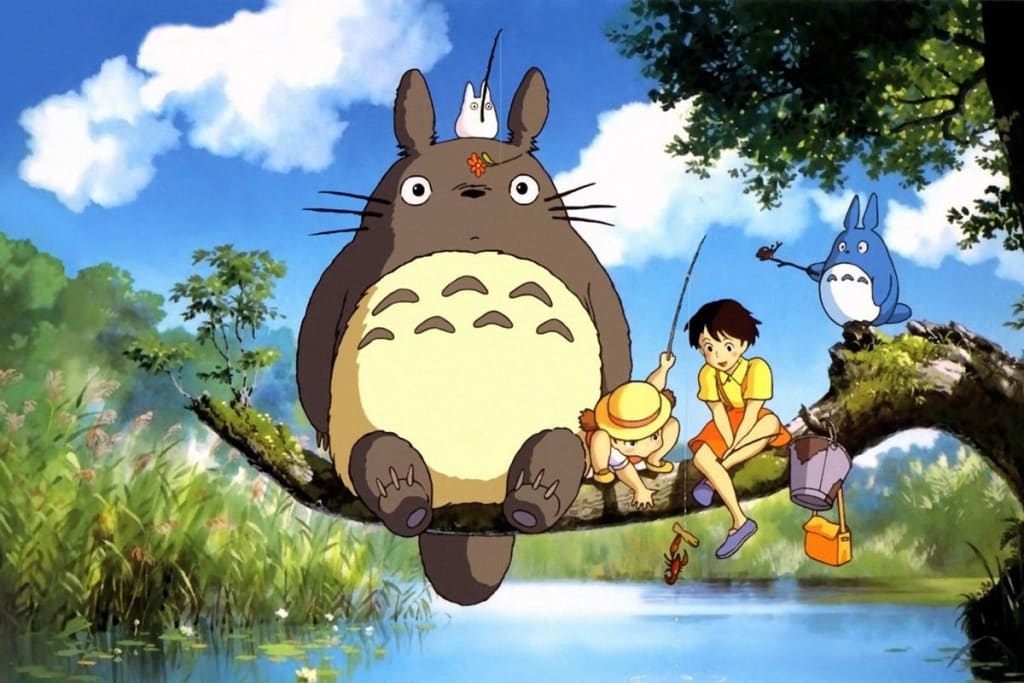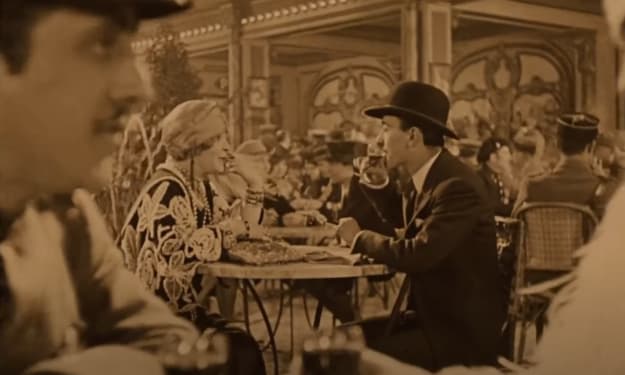Totoro is a Masterpiece
Film Retrospective

So at this point my two year old daughter and I have watched “My Neighbor Totoro" at least ten times and all I can say is that it is nothing short of a masterpiece. That really is not that much of a shocking revelation though is it. I mean each and every Miyazaki film is often heralded as the best thing since sliced bread. I have seen several of them over the years and all of them have been something special. But Totoro, man what an experience this film is. I wanted to sit down and express why it speaks to me so personally and why I think it is a masterpiece in filmmaking.
Establishment
The film begins with a cute opening tune. To be clear I am going to be looking at the Disney English dub of the film and the opening song is sung by country music singer Sonya Isaacs. The opening scene introduces the main cast as they are moving to the country. We are also shown their new environment with the same enthusiasm as the little girls Satsuki and Mei. That youthful enthusiasm is on full display as they run from one adventure to another uncovering the mysteries of the old house that is now their home. Voiced by real life sisters Dakota and Ellie Fanning, they do a wonderful job bringing the two main characters to life. Dakota balances Satsuki’s growing maturity and responsibility with her still very youthful and innocent qualities. Ellie also shines, giving Mei an innocence but also effectively conveying the mischievous nature of preschool children.
The setting is 50’s rural Japan which is whimsical and foreign in its own special way to modern audiences as well as anyone who saw this film when it was new. The landscapes are incredibly beautiful, rich with detail and vibrant color. We also get eased into the fantastical elements of the story through the soot sprites, a type of yokai that we are told occupy uninhabited houses and leave if the people who live there are “good people.” The movie does not introduce Totoro right away but hints at his existence more than once. The soot sprites do indeed leave after the first night, telling by showing contextually still more information about this family. Indeed showing and not telling is a great strength of the film. To the viewer who is paying close enough attention they are rewarded with extra detail and immersion.
The relationships between the girls and the father are also firmly established during this section of the film in the same subtle manner. Tatsua, the father, is supportive of the girls and fuels their imaginations, never questioning what they see or calling into doubt what they experience. My favorite of his lines is, “great I always wanted to live in a haunted house.” Voiced by Tim Daly, none other than Super-Man himself. Tim brings the same charm to this character as the aforementioned super hero, instantly calming any fears the girls or even the audience might have of the malicious intent of the strange phenomenon at play around the home. Indeed he almost seems to know something that the rest of us don’t and is calm and even aloof throughout the film. I have to admit that hearing his voice all fatherly makes me uneasy for some reason, (clip from Justice league). Anyway the next principal character introduced in this section is granny. Not actually related to the girls, this older character further bucks tropes by being just as supportive as the father of the girls' imaginations and discoveries. Played by Pat Carol, who many may know best as Ursuala from the little mermaid, she gives such a kind and warm performance in this role. In fact the scene later in the film where she is holding the slipper praying it is not Mei’s brought me to tears on more than one occasion. But here she highlights further that something else is missing from this happy family, where is mom?
The film does such a wonderful job of establishing the setting and characters in natural ways with incredibly human interactions, subtly feeding the audience information on what to expect without dipping too deep into cliche. It is quick and snappy which is equally refreshing compared to the often needlessly bloated intros of films in general. Miyazaki and his films are praised for celebrating the beauty of the mundane. The scene where the girls get the pump running is an excellent example. The art of the film is visually captivating, no matter what is going on you scan the foreground and the background for every detail.
Framing
The film is rich with subtextual framing rich in Japanese culture. Shintoism is a present theme in the film with Yokai and spiritual connections to nature being prevalent. Spirits of the forest, is often the explanation given to the mysterious occurrences by the adults and Shintoism
Animation
So where is the conflict? In any story intrigue is often found in conflict and this film's conflict has been hinted at but not outright addressed in the opening. This is a happy healthy group of individuals, emotionally and physically, but they are not complete. Dad and the girls ride their bicycle to town to visit mom who is recovering from an illness in the hospital. The novelization identifies her illness as tuberculosis and since this was the illness that Miyzaki’s own mother struggled with when he was a boy it makes sense. The conflict is laid out in this section subtly, just like everything else in this movie. When the mom is brushing the girls hair she remarks on Mie’s hair and Satsuki. Mei’s hair is pulled up in cute pigtails but Satsuki has cut her hair short. Satsuki is taking up a motherly role in the family, filling the void left by her mother as best she can. But this has forced her to neglect herself, her own childhood joys. She keeps her own hair short to give more time to Mei. Mom remarks in the film she is concerned about this and promises to spoil both girls when she is well and returns home. Satsuki expresses her own frustration with Mei remarking that while fixing her hair Mei was misbehaving.
This conflict is expounded upon by Satsuki making everyone breakfast and lunch before school and missing out on Totoro because she has responsibilities. She is disappointed, saying she wants to see Totoro. It is a metaphor for the situation she finds herself in, being forced to grow up is robbing her of her childhood. We see the joy of her child self when she finally does see Totoro, standing in the rain, holding Mei on her back she struggles with the burdens placed on her, but Totoro shows up and stands with her in the rain even ending the storm after she offers him the umbrella. Her and Mei see the cat bus together before their father finally makes it home that day. Every interaction with this mystical world revolves around the two girls but Satsuki misses out on some of the early interactions by “growing up to fast.” Satsuki is stuck between the role her mother represents but can not fulfill and the role Mei represents that she should be sharing. What makes it all the more compelling is that it is not some villain stealing her youth but just circumstances. The whole situation is incredibly realistic and relatable. More than the hero’s journey this is the human journey.
Satuski writes letters to her mother expressing the adventures she and Mei are having with Totoro. The scene of the growing tree, where the girls and Totoro grow the seeds into a forest is a climactic moment in the film. Here the girls are what all kids their age should be. Worry free and full of joy experiencing the magic of their youth. Mei jumps to Totoro immediately whereas Satsuki hesitates before finally jumping in herself. All the while the father smiles a knowing smile. It is not just that he knows something we don’t. He is happy because the girls are free from the worries of their world. The family, including their mom, is healing. There is a light shining at the end of the tunnel.
Intensification
But then a planned weekend with mom is interrupted by a telegram. Satsuki’s strong front breaks down. Mei is inconsolable and understandably so, but Satsuki can not console her because she herself is breaking down. Her mothers prediction comes true and she crumbles, just for a moment, under the unfair burden life has placed on her. Sometimes having support, like a good dad, or granny or even a magical forest spirit, is just not enough. Things escalate further when Mei becomes lost trying to get to the hospital herself to see her mother. Satsuki runs and runs in search of her, looking for help in finding her sister. For the audience the scene is terrifying as we experience with Satsuki the helplessness of the moment. This section of the film is emotionally gripping and I held my breath and even cried at some of the most desperate moments. There is no world ending threat, not like we are used to in films that are popular these days. But the film has connected us to the characters so powerfully that the terror is real to us. Is Mei okay? Is the mom okay?
With no other options Satsuki turns to one last desperate hope, Totoro. Finding resolution through Totoro and the friends that she made by being and acting like a child is such a beautiful metaphor in the film. It is not an adult who rescues Satsuki and Mei from this hopeless situation, but their bond with the film's representation of childlike wonder who comes through and their bond to one another.
Resolution
The film resolves quickly when Mei is found thanks to the Cat-Bus and the girls are assured their mother is going to recover. The family is ultimately restored and they start their new lives together in the country house. The efficiency in the manner that the story is told is reflected in its resolution. Some might feel the ending is abrupt but to me the nature of the ending is all the more rooted in reality. In life often our roads are paved in little crises. Traumatic nonetheless but they often build up slowly, flare up quickly and resolve equally so. For a film named for a giant magical beast it is incredibly human and real.
Impressions
Where do I start? The art direction and characters are full of detail that leaps off the screen. The film has a youthful energy that takes me back to my own childhood running through pine trees with my brother and cousins. We would play games for hours imagining we were explorers in an untamed wilderness. The story is relatable and layered under what appears at first to be a simple premise. The musical arrangements are equally whimsical, inviting us into this world that combines the strange and the familiar seamlessly. The films focus on trauma that is common to all families but often not discussed in any artform. Sometimes the temporary removal of a pivotal person in a family unit, even temporary, can be traumatic. It can put strain on even healthy and emotionally capable people. It has costs that sometimes are difficult to anticipate and even more difficult to measure. But in the end love finds a way to see us through. Sometimes the solution is not to grow up, but to let go and express a child like faith. Without the childlike wonder of these girls expressing their youth, Totoro would not have been there when they needed them. We as humans can not always shoulder the burden of the world alone. We need help, we need to let people in. To make friends and play so that when things are serious, we know who we can count on and where to find them. The film's ultimate message to me though is the power of listening. The father listens to his children, granny listens to the girls and the mom listens when she can. But Satsuki listening to Mei when she tells her about Totoro and where to find him, “This is Totoro’s tree,” equips her for later in the film. Indeed the greatest disaster in the film is when the hospital communicates poorly with the family which leads to Mei getting lost. We could all be better listeners, not just hearing but encouraging each other patiently. I know that I certainly could.
About the Creator
Gray Beard Nerd
A nerd who is into cars, video games, movies, book and more. I love to write and hope to share what I have written with others. Please enjoy!!






Comments
There are no comments for this story
Be the first to respond and start the conversation.